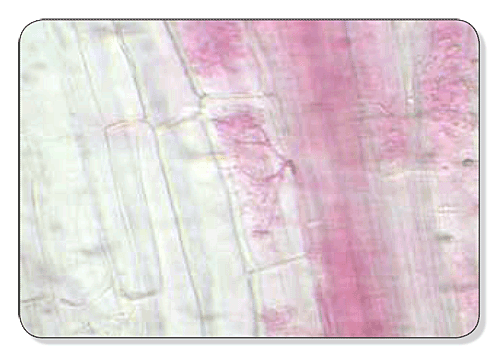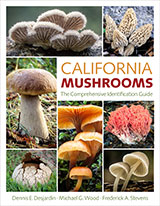How Plants Colonized the Land
It’s understandable that most botanists tend to focus on what’s going on above ground. It’s the world we can touch and see easily, and it’s where the most striking parts of the plant are—flowers, leaves, stems. For most fungi though, private creatures that they are, life really happens below ground, away from the prying eyes of mycologists. We’re reminded of this every year when our favorite fungi fruit ever so briefly and then retreat beneath the ground, lying in wait for the next storm. To use a botanical analogy, it would be as if the entire body of the plant—leaves and stem—was below ground, and only the flowers and fruits would occasionally peek their heads into the air. (You can imagine how impatient botanists might get waiting for spring.) Because of this bias, it’s easy to think of plants as truly independent creatures, putting out their leaves and basking in the sunshine. In reality though, plants are involved in a constant below-ground battle to pull up enough water and nutrients from the soil to feed their leaves and keep photosynthesis running. In fact, extracting water and nutrients from the soil has been the most important challenge for plants ever since the first green algae left the water and colonized the land. And, ever since plants began to colonize the land, fungi have been there to help.

An arbuscule from a plant growing on serpentine soils. This is the same sort of structure that has been found in fossilized plants some 400 million years ago. (Photograph by Shannon Shechter)
Most people are probably familiar with mycorrhizal symbiosis, a mutualistic relationship between plants and fungi. In some ways, the best analogy for mycorrhizal symbiosis is an economic one. Plants are very good at taking sunlight and converting it to energy (i.e. carbon) through photosynthesis, but bad at getting nutrients and water out of the soil. Fungi are pretty well designed for growing through the soil and scavenging for nutrients and water, but not quite so good at getting carbon. As a result, many plants and fungi trade carbon and nutrients much in the same way nations might trade sugar and aluminum. As some indication of the importance of this relationship, approximately 90% of “higher” plants (i.e. flowering plants and conifers) are involved in some type of mycorrhizal symbiosis. But has it always been so?
The earliest land plants evolved from green algae, that living in the water, had little use for specialized structures to absorb water and nutrients. As such, many of the earliest land plants did not have true “root” systems, but instead possessed a modified stem, referred to as a rhizome, and root-like structures known as rhizoids, which served mainly as anchors to the soil. The evolution from primitive land plants to modern flora dominated by angiosperms (flowering plants) and gymnosperms (conifers) can be seen in many ways as a progression towards more sophisticated structures for dealing with life on land, such as a more complicated rooting system and a well developed vasculature that is more efficient at transporting water and nutrients from the soil to the canopy.
Modern plants with extensive root systems still benefit incredibly from associations with mycorrhizal fungi, so it is reasonable to assume that the earliest plants, with their primitive root systems, would have benefited considerably as well. In fact, in an article by D.J. Read and others (2000), the authors point out that there is evidence from species living today that those plants with poorly developed root systems are much more responsive to mycorrhizal fungi than those plants with more finely branched rooting systems. By implication, the earliest land plants with their primitive roots would probably have benefited dramatically from mycorrhizal colonization.
Aside from such logical inferences, there is also extensive fossil evidence that suggests that the first land plants were already involved in mycorrhizal symbiosis. One of the most widespread types of mycorrhizal symbiosis, arbuscular mycorrhizas, is characterized by the presence of hyphae that penetrate root cells and form highly branched structures. Because of their characteristic appearance, these structures are named “arbuscules,” from the Latin word for bush (see image). Amazingly, fossilized plants dating from some 400 million years ago show well preserved structures that look identical to modern arbuscules (Remy and others, 1994). Since the earliest plant fossils also date back about 450 million years, during the Silurian Period, it appears very likely that the first land plants had mycorrhizal associations. Furthermore, a “molecular clock” based on genetic mutation rates also place the origins of the Glomeromycota, the phylum of fungi involved in arbuscular mycorrhizal symbiosis, between 450–360 million years ago (Simon and others, 1993).
More evidence that fungi were instrumental in the colonization of land comes from the analysis of plant-fungal symbiosis among “living fossils.” While most of the species in the flora today come from groups that evolved relatively recently, there are still a number of extant species that represent the earliest lineages of land plants. These “lower” plants, such as the mosses, liverworts, ferns, and horsetails, still have rhizomes and lack well developed vasculature. Unsurprisingly, a number of these lower plants have well documented associations with a wide range of fungi. While the effect of these associations in promoting plant growth is still a subject of ongoing research, they often involve arbuscular mycorrhizal fungi and produce fungal structures in the root that resemble arbuscules.
Overall, the evidence seems to suggest that the colonization of land by plants was a fungal mediated process. So, while it’s easy to look at the flowers and leaves and ignore what’s going on below ground, in reality, without fungi all of our land plants would probably still be algae.
Further reading:
- Read DJ, Duckett JG, Francis R, Ligrone R & Russel A. (2000). Symbiotic fungal associations in “lower” land plants. Philosophical Transactions of the Royal Society of London B, 355: 815-831. (PDF)
- Remy W, Taylor TN, Hass H & Kerp H. (1994). Four hundredmillion-year-old vesicular arbuscular mycorrhizae. Proceedings of the National Academy of Sciences, 91: 11841-11843. (PDF)
- Simon L, Bousquet J, Levesque RC & Lalonde M. (1993). Origin and diversification of endomycorrhizal fungi and coincidence with vascular land plants. Nature, 363: 67-69. (Abstract)

